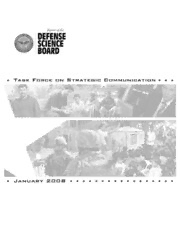
DTIC ADA476331: Report of the Defense Science Board Task Force on Strategic Communication PDF
Preview DTIC ADA476331: Report of the Defense Science Board Task Force on Strategic Communication
Report Documentation Page Form Approved OMB No. 0704-0188 Public reporting burden for the collection of information is estimated to average 1 hour per response, including the time for reviewing instructions, searching existing data sources, gathering and maintaining the data needed, and completing and reviewing the collection of information. Send comments regarding this burden estimate or any other aspect of this collection of information, including suggestions for reducing this burden, to Washington Headquarters Services, Directorate for Information Operations and Reports, 1215 Jefferson Davis Highway, Suite 1204, Arlington VA 22202-4302. Respondents should be aware that notwithstanding any other provision of law, no person shall be subject to a penalty for failing to comply with a collection of information if it does not display a currently valid OMB control number. 1. REPORT DATE 3. DATES COVERED JAN 2008 2. REPORT TYPE 00-00-2008 to 00-00-2008 4. TITLE AND SUBTITLE 5a. CONTRACT NUMBER Task Force on Strategic Communication 5b. GRANT NUMBER 5c. PROGRAM ELEMENT NUMBER 6. AUTHOR(S) 5d. PROJECT NUMBER 5e. TASK NUMBER 5f. WORK UNIT NUMBER 7. PERFORMING ORGANIZATION NAME(S) AND ADDRESS(ES) 8. PERFORMING ORGANIZATION Office of the Under Secretary of Defense for ,Acquisition, Technology and REPORT NUMBER Logistics,Defense Scince Board,Washington,DC,20301-3140 9. SPONSORING/MONITORING AGENCY NAME(S) AND ADDRESS(ES) 10. SPONSOR/MONITOR’S ACRONYM(S) 11. SPONSOR/MONITOR’S REPORT NUMBER(S) 12. DISTRIBUTION/AVAILABILITY STATEMENT Approved for public release; distribution unlimited 13. SUPPLEMENTARY NOTES 14. ABSTRACT 15. SUBJECT TERMS 16. SECURITY CLASSIFICATION OF: 17. LIMITATION OF 18. NUMBER 19a. NAME OF ABSTRACT OF PAGES RESPONSIBLE PERSON a. REPORT b. ABSTRACT c. THIS PAGE Same as 158 unclassified unclassified unclassified Report (SAR) Standard Form 298 (Rev. 8-98) Prescribed by ANSI Std Z39-18 This report is a product of the Defense Science Board (DSB). The DSB is a Federal Advisory Committee established to provide independent advice to the Secretary of Defense. Statements, opinions, conclusions, and recommendations in this report do not necessarily represent the official position of the Department of Defense. The DSB Task Force on Strategic Communication in the 21st Century completed its information gathering in August 2007. This report is unclassified and cleared for public release. Cover photos courtesy of the Department of Defense and U.S. Agency for International Development OFFICE OF THE SECRETARY OF DEFENSE 314 0 DEFENSE PENTAGON WASHINGTON. DC 2030 1-31 40 December 17 ,2007 DEFENSE SCIENCE BOARD MEMORANDUM TO THE CHAIRMAN, DEFENSE SCIENCE BOARD SUBJECT: Final Report of the Defense Science Board Task Force on Strategic Communication Strategic communication, coordinated and executed in association with all aspects of national power, can help prevent and limit conflicts as well as enhance responses to global challenges that threaten America's interests and values. This view of the Defense Science Board remains unchanged in this, its third study on the topic of strategic communication. But as the world has changed, the board has refined its views on matters of implementation and relationship building, which are reflected in this report. Strategic communication is a dynamic process with responsibility held by those at the highest levels of government-the President and senior government leaders. It must be executed with shared knowledge and strong, adaptive networks within government and between government and civil society. But to do so requires a commitment not yet seen, though some steps have been taken to improve the nation's capability. What is needed is a transformation supported by resources and strength of purpose that matches the nation's commitment to defense, intelligence, law enforcement, and homeland security. The task force has identified a number of actions that would enable such a transformation: Create an independent, non-profit, and non-partisan Center for Global Engagement as a focal point for strategic communication activities, bringing together government and non-government leaders and expertise. Create a permanent strategic communication structure within the White House, one element of which would be a Deputy National Security Advisor and Assistant to the President for Strategic Communication. Make greater use in the Department of Defense of existing tools and technologies to support strategic communication-tools such as network analysis, machine translation, and innovative evaluation and measurement technologies. Enhance the policy, budget and personnel authorities for the Under Secretary of State for Public Diplomacy and Public Affairs. Conduct a review of the mission, structure, funding, and performance of the Broadcasting Board of Governors, as an integral element of the overall U.S. strategic communication capability. Create, within the Department of Defense, a permanent Deputy Under Secretary of Defense for Strategic Communication, reporting to the Under Secretary of Defense for Policy. Each of these recommendations, and others that support them, are discussed in detail in this report. Important to understand, and highlighted throughout this report, is that a transformation in strategic communication can begin immediately, as many of these recommendations can be acted on today. Taking such action can improve the nation's capability to use this increasingly powerful, multi- dimensional instrument that is critical to America's interests and to achieving the nation's strategic goals. Vincent Vitto Chairman TABLE OF CONTENTS I vii Table of Contents Executive Summary.......................................................................................ix Chapter 1. Introduction.................................................................................1 Effective Strategic Communication is Vital to Achieve U.S. Strategic Objectives............................................................................3 Positive Changes Implemented: Department of State........................4 Positive Changes Implemented: Department of Defense..................7 Chapter 2. What is Strategic Communication and Why Does it Matter?.........................................................................10 Strategic Communication is an Interactive Process..........................11 Strategic Communication Depends on Cultural Context.................13 Strategic Communication Must Be Agile............................................15 Historic Strategic Communication Successes.....................................17 Strategic Communication Challenges..................................................18 Transforming Strategic Communication.............................................19 Chapter 3. The World is Changing.............................................................21 Multiple Dimensions of Change..........................................................21 Positive Trends: Opportunities............................................................26 Negative Trends: Threats......................................................................27 Anti-Americanism on the Rise.............................................................29 Implications for Strategic Communication.........................................37 Chapter 4. Technology is Changing...........................................................40 Media Transformation...........................................................................40 Technology Transformation.................................................................52 Chapter 5. Engaging National Capability..................................................63 Strategic Communication Originating in the United States has Many Sources.............................................................................64 Community-Building through Information Affluence.....................72 Personal Interactions as Compelling Messages..................................76 Organizing the U.S. Government for Integrated Strategic Communication.................................................................................81 Chapter 6. Conclusions and Recommendations.......................................88 Center for Global Engagement............................................................89 Strategic Communication Leadership..................................................94
